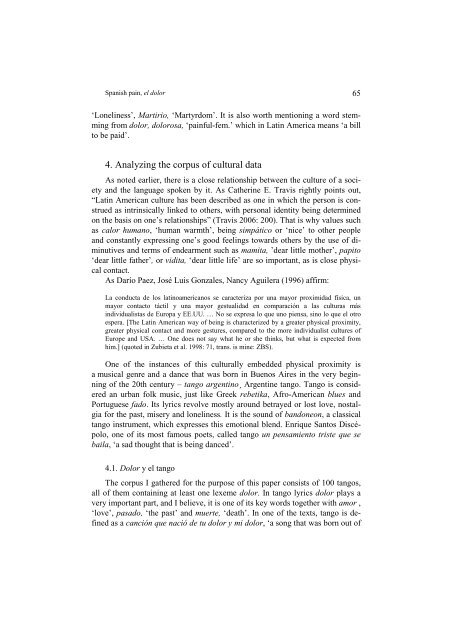s - Wyższa SzkoÅa Filologiczna we WrocÅawiu
s - Wyższa SzkoÅa Filologiczna we WrocÅawiu
s - Wyższa SzkoÅa Filologiczna we WrocÅawiu
You also want an ePaper? Increase the reach of your titles
YUMPU automatically turns print PDFs into web optimized ePapers that Google loves.
Spanish pain, el dolor 65<br />
‘Loneliness’, Martirio, ‘Martyrdom’. It is also worth mentioning a word stemming<br />
from dolor, dolorosa, ‘painful-fem.’ which in Latin America means ‘a bill<br />
to be paid’.<br />
4. Analyzing the corpus of cultural data<br />
As noted earlier, there is a close relationship bet<strong>we</strong>en the culture of a society<br />
and the language spoken by it. As Catherine E. Travis rightly points out,<br />
“Latin American culture has been described as one in which the person is construed<br />
as intrinsically linked to others, with personal identity being determined<br />
on the basis on one’s relationships” (Travis 2006: 200). That is why values such<br />
as calor humano, ‘human warmth’, being simpático or ‘nice’ to other people<br />
and constantly expressing one’s good feelings towards others by the use of diminutives<br />
and terms of endearment such as mamita, ’dear little mother’, papito<br />
‘dear little father’, or vidita, ‘dear little life’ are so important, as is close physical<br />
contact.<br />
As Darío Paez, José Luis Gonzales, Nancy Aguilera (1996) affirm:<br />
La conducta de los latinoamericanos se caracteriza por una mayor proximidad física, un<br />
mayor contacto táctil y una mayor gestualidad en comparación a las culturas más<br />
individualistas de Europa y EE.UU. … No se expresa lo que uno piensa, sino lo que el otro<br />
espera. [The Latin American way of being is characterized by a greater physical proximity,<br />
greater physical contact and more gestures, compared to the more individualist cultures of<br />
Europe and USA. … One does not say what he or she thinks, but what is expected from<br />
him.] (quoted in Zubieta et al. 1998: 71, trans. is mine: ZBS).<br />
One of the instances of this culturally embedded physical proximity is<br />
a musical genre and a dance that was born in Buenos Aires in the very beginning<br />
of the 20th century – tango argentino¸ Argentine tango. Tango is considered<br />
an urban folk music, just like Greek rebetika, Afro-American blues and<br />
Portuguese fado. Its lyrics revolve mostly around betrayed or lost love, nostalgia<br />
for the past, misery and loneliness. It is the sound of bandoneon, a classical<br />
tango instrument, which expresses this emotional blend. Enrique Santos Discépolo,<br />
one of its most famous poets, called tango un pensamiento triste que se<br />
baila, ‘a sad thought that is being danced’.<br />
4.1. Dolor y el tango<br />
The corpus I gathered for the purpose of this paper consists of 100 tangos,<br />
all of them containing at least one lexeme dolor. In tango lyrics dolor plays a<br />
very important part, and I believe, it is one of its key words together with amor ,<br />
‘love’, pasado, ‘the past’ and muerte, ‘death’. In one of the texts, tango is defined<br />
as a canción que nació de tu dolor y mi dolor, ‘a song that was born out of
















